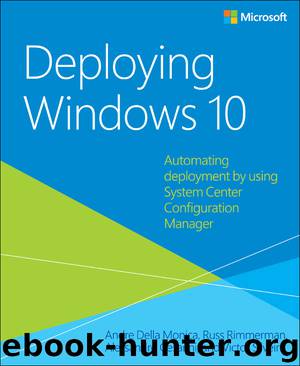Deploying Windows 10: Automating deployment by using System Center Configuration Manager

Author:Andre Della Monica & Russ Rimmerman & Alessandro Cesarini & Victor Silveira
Language: eng
Format: epub
Publisher: Microsoft Press
Published: 2016-06-26T16:00:00+00:00
Figure 3-1: Site system roles for OSD
Following is a description of each of the roles
The Distribution Point (DP) required role provides content during deployments. Types of content consist of applications, software packages, software updates, OS images, and device driver packages. This site system role could be placed in remote office branches to provide clients with a local content source to avoid downloading large content files such as WIMs over the WAN links. Bandwidth throttling and scheduling options are available to control content distribution and, alternatively, a Pull function to enhance bandwidth usage over WAN links. It accommodates network startup if PXE is turned on. If you do want to turn on PXE startup functionality, you will need Windows Deployment Services and a DHCP server with IP helper configurations on network routers.
The Management Point (MP) required role provides clients with configuration and deployment policies and assists in identifying content location for software retrieval based on the client’s network location. It also receives configuration data from clients and state messages for reporting during a deployment. The MP role typically is located alongside the Primary Site Server, and there can be more than one, depending on the number of clients being managed to distribute the load.
The State Migration Point (SMP) optional role maintains user state data from systems being refreshed or replaced. You can also set the retention period for the user’s data on this site system.
The Software Update Point (SUP) optional role is used to determine which software updates would be applicable to a machine during the build process and throughout the life of the computer while it is managed by Configuration Manager. This site system requires that Windows Server Update Services (WSUS) is installed prior to configuration.
The Fallback Status Point (FSP) optional role provides an alternative method for clients to report any client agent installation or client communication–related issues with the MP.
Aside from the site system roles, the Network Access Account is a requirement of OSD for authentication and access to the Configuration Manager environment by clients.
Download
This site does not store any files on its server. We only index and link to content provided by other sites. Please contact the content providers to delete copyright contents if any and email us, we'll remove relevant links or contents immediately.
Adobe Camera Raw For Digital Photographers Only by Rob Sheppard(16907)
The Mikado Method by Ola Ellnestam Daniel Brolund(16902)
Hello! Python by Anthony Briggs(16470)
Dependency Injection in .NET by Mark Seemann(15051)
OCA Java SE 8 Programmer I Certification Guide by Mala Gupta(14768)
Secrets of the JavaScript Ninja by John Resig Bear Bibeault(14131)
The Well-Grounded Java Developer by Benjamin J. Evans Martijn Verburg(14106)
Algorithms of the Intelligent Web by Haralambos Marmanis;Dmitry Babenko(13447)
Kotlin in Action by Dmitry Jemerov(12967)
Grails in Action by Glen Smith Peter Ledbrook(12698)
Sass and Compass in Action by Wynn Netherland Nathan Weizenbaum Chris Eppstein Brandon Mathis(11400)
A Developer's Guide to Building Resilient Cloud Applications with Azure by Hamida Rebai Trabelsi(10562)
Secrets of the JavaScript Ninja by John Resig & Bear Bibeault(9707)
Test-Driven iOS Development with Swift 4 by Dominik Hauser(9516)
Hit Refresh by Satya Nadella(9041)
The Kubernetes Operator Framework Book by Michael Dame(8509)
Exploring Deepfakes by Bryan Lyon and Matt Tora(8320)
Robo-Advisor with Python by Aki Ranin(8276)
Practical Computer Architecture with Python and ARM by Alan Clements(8249)
